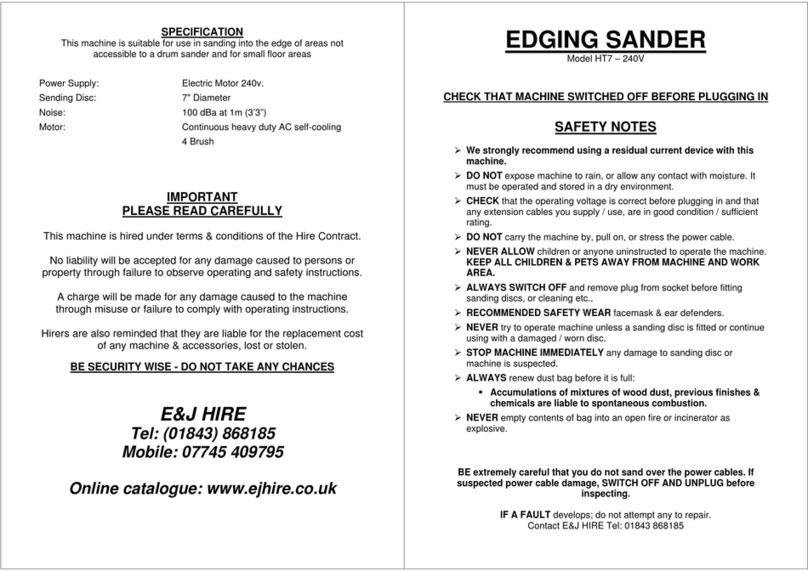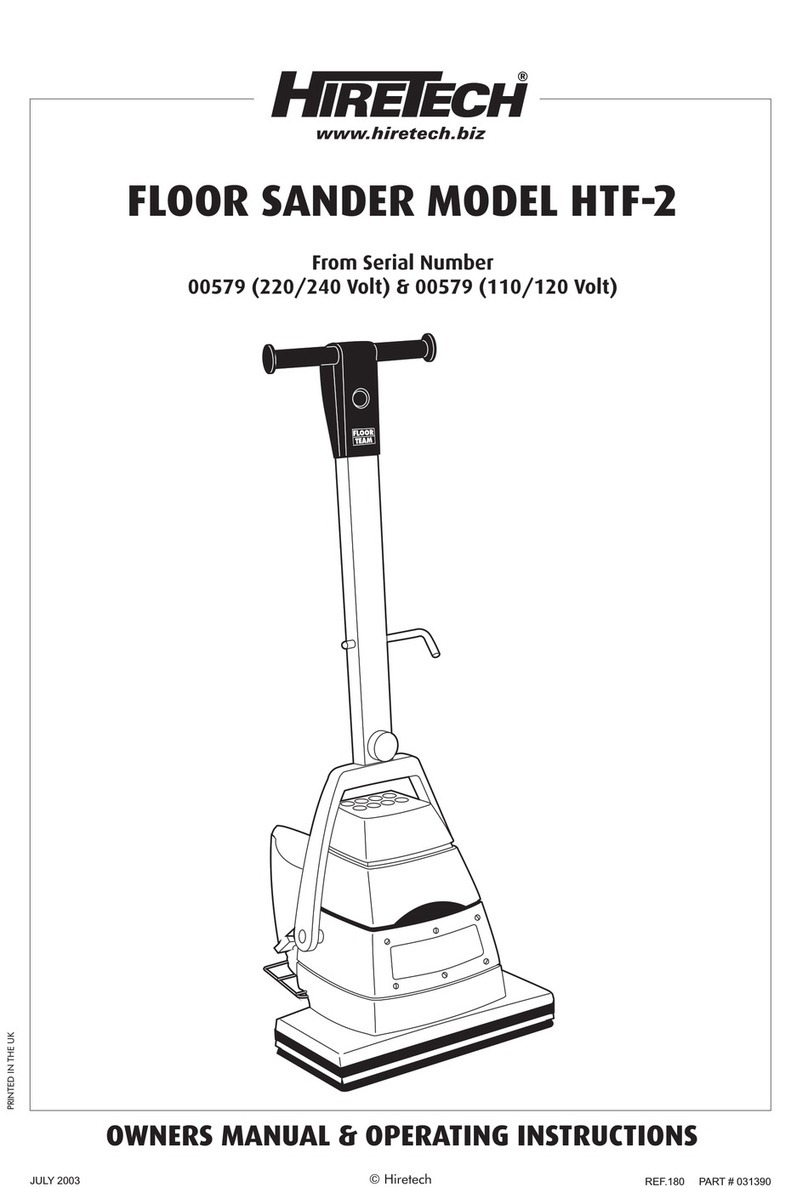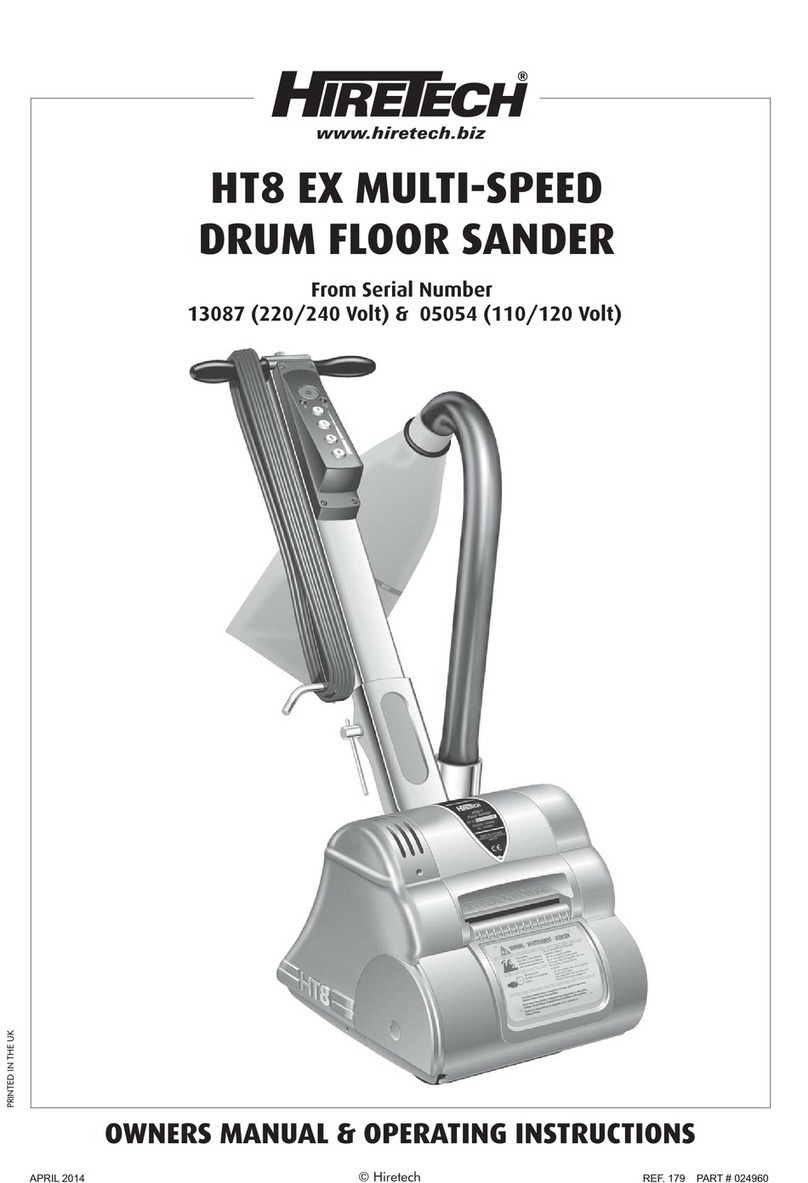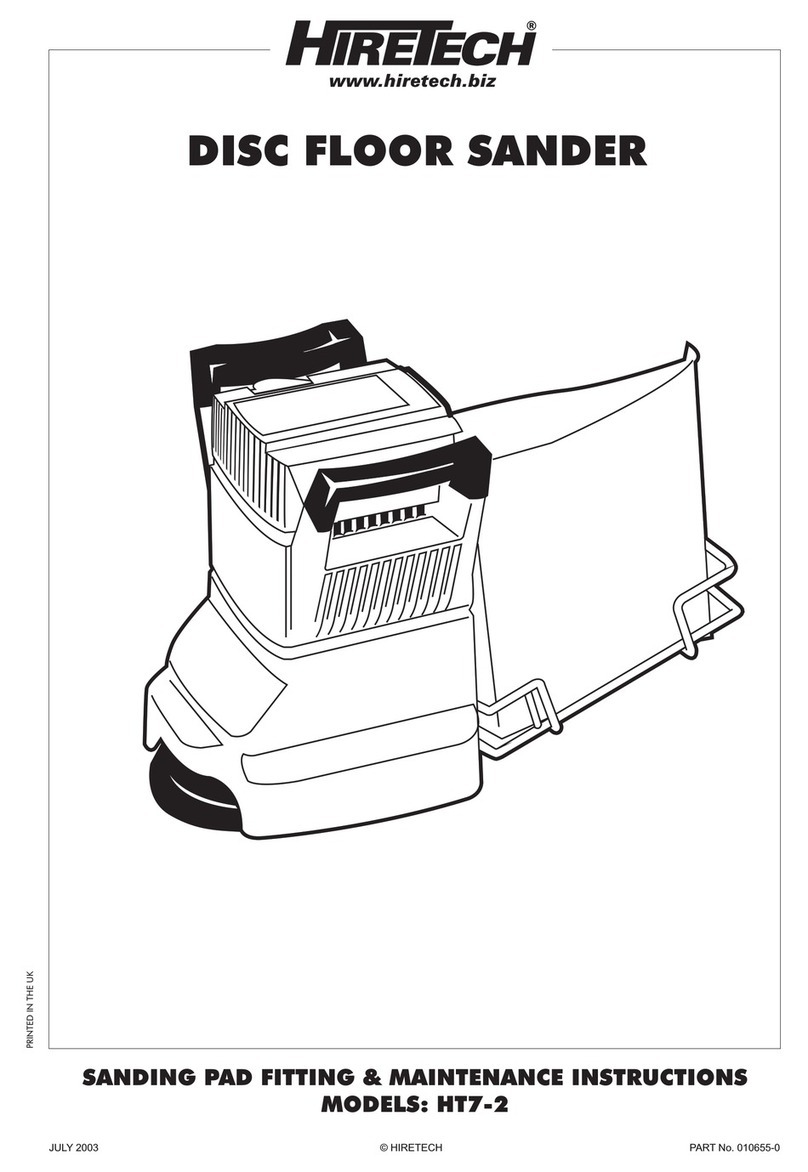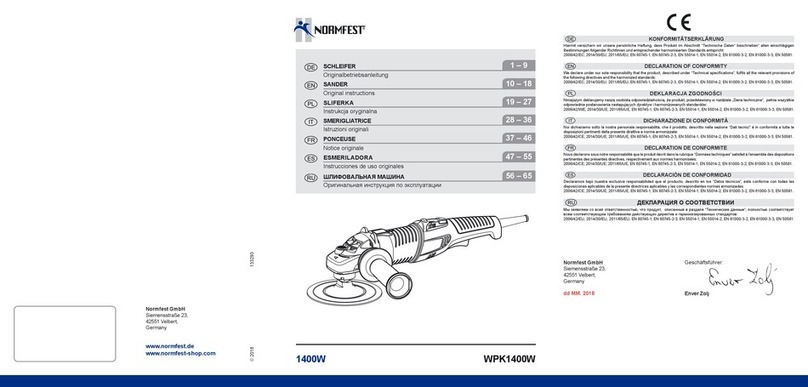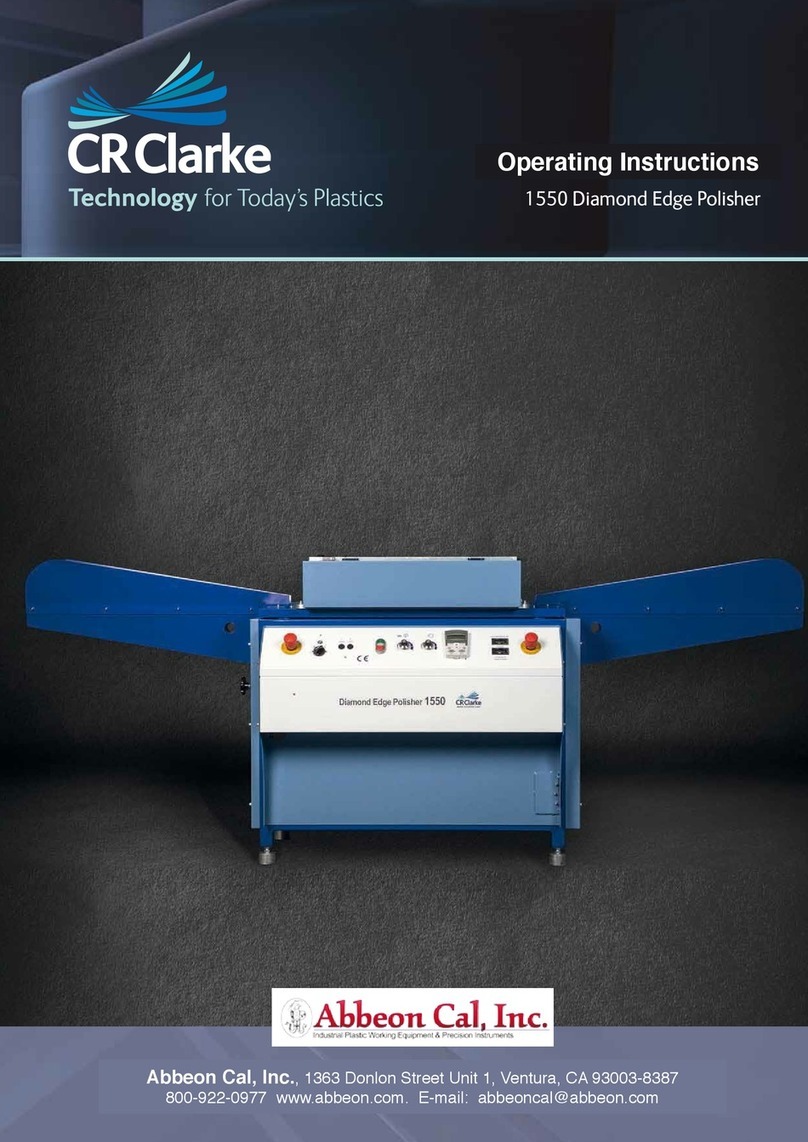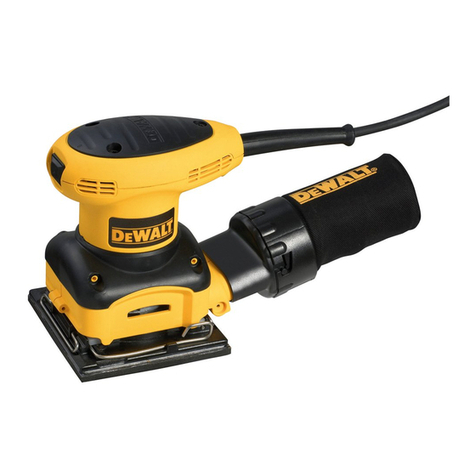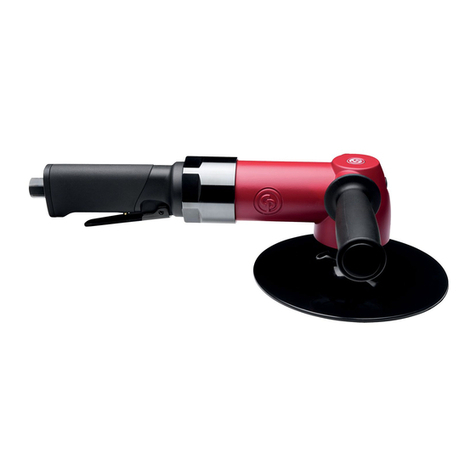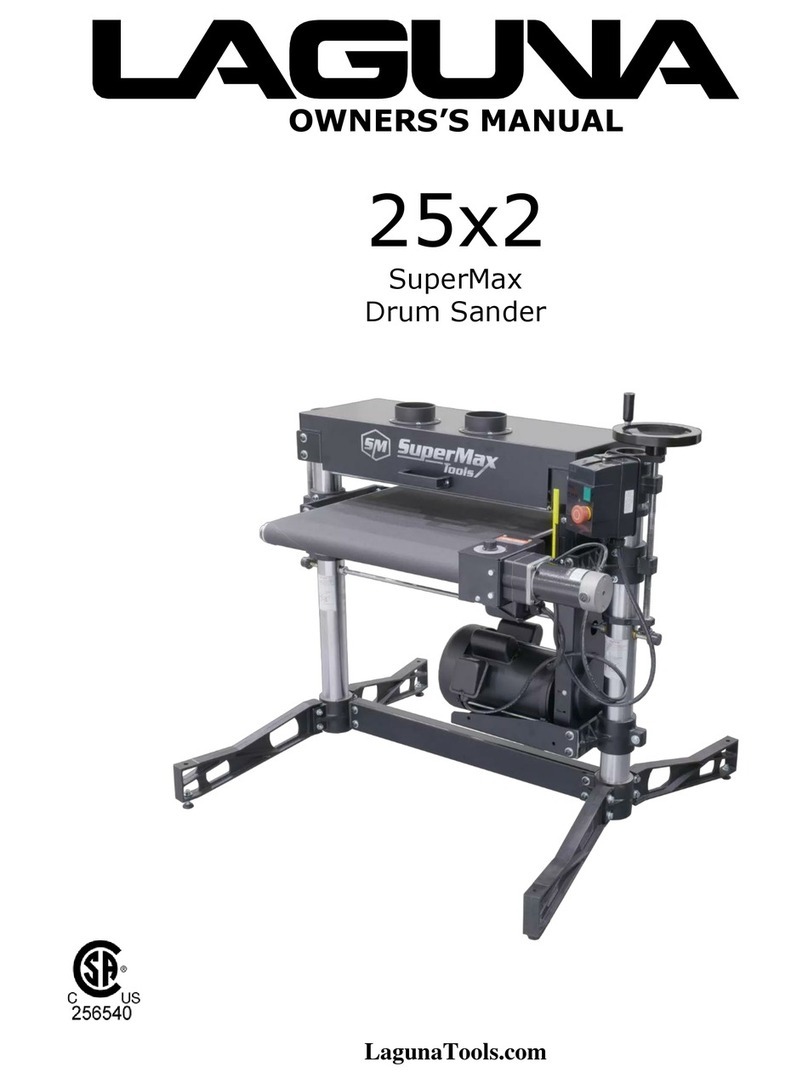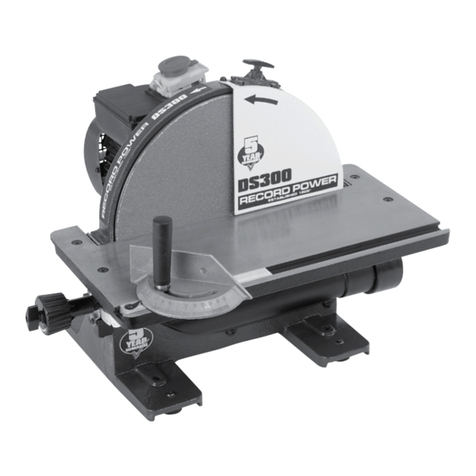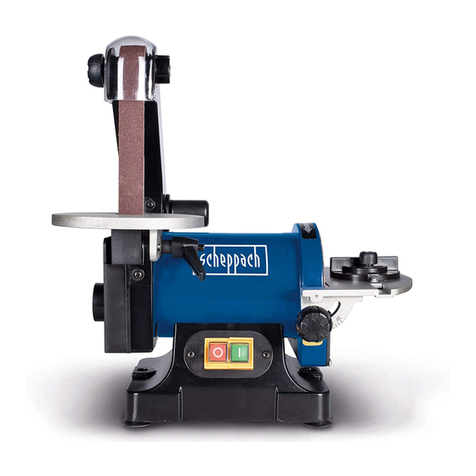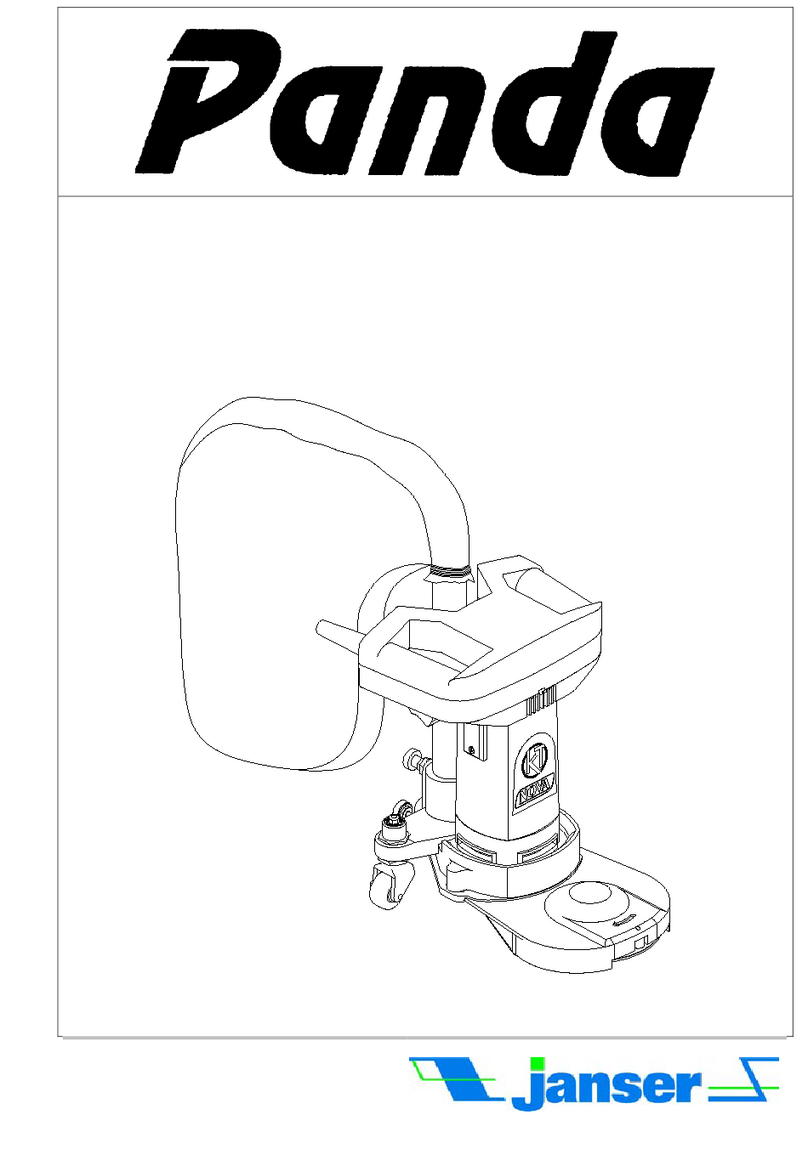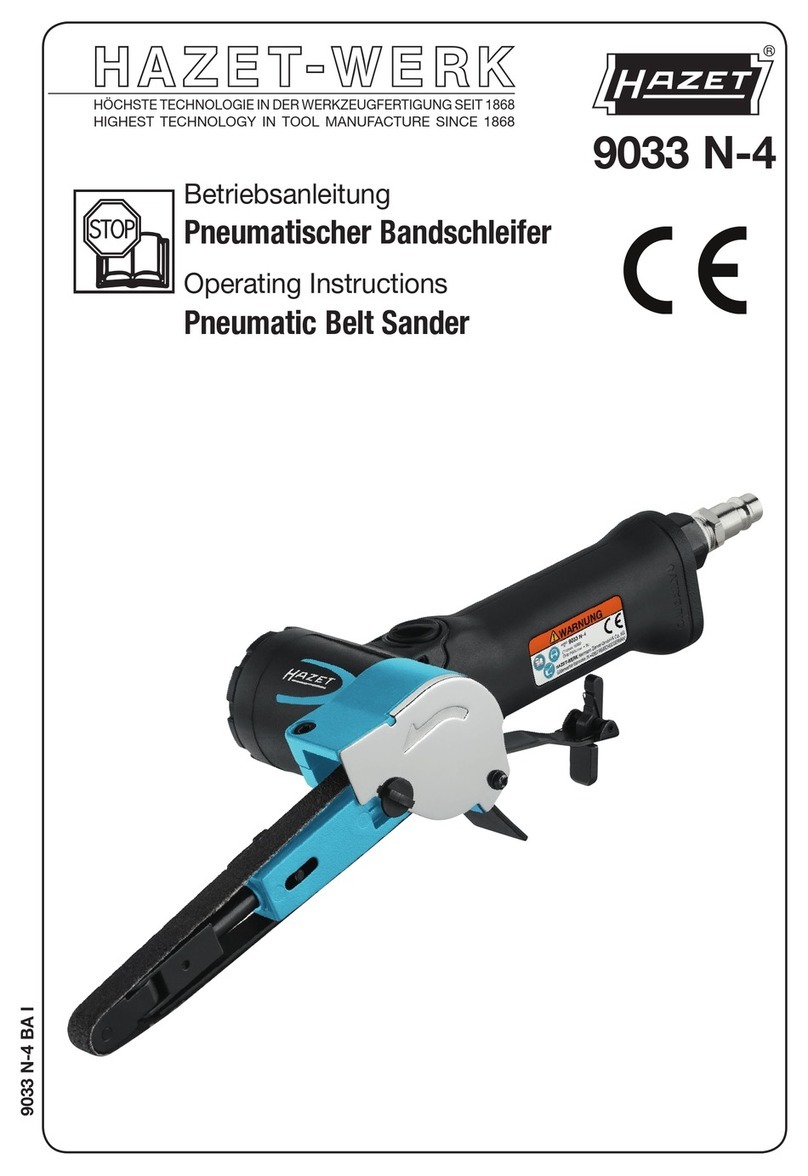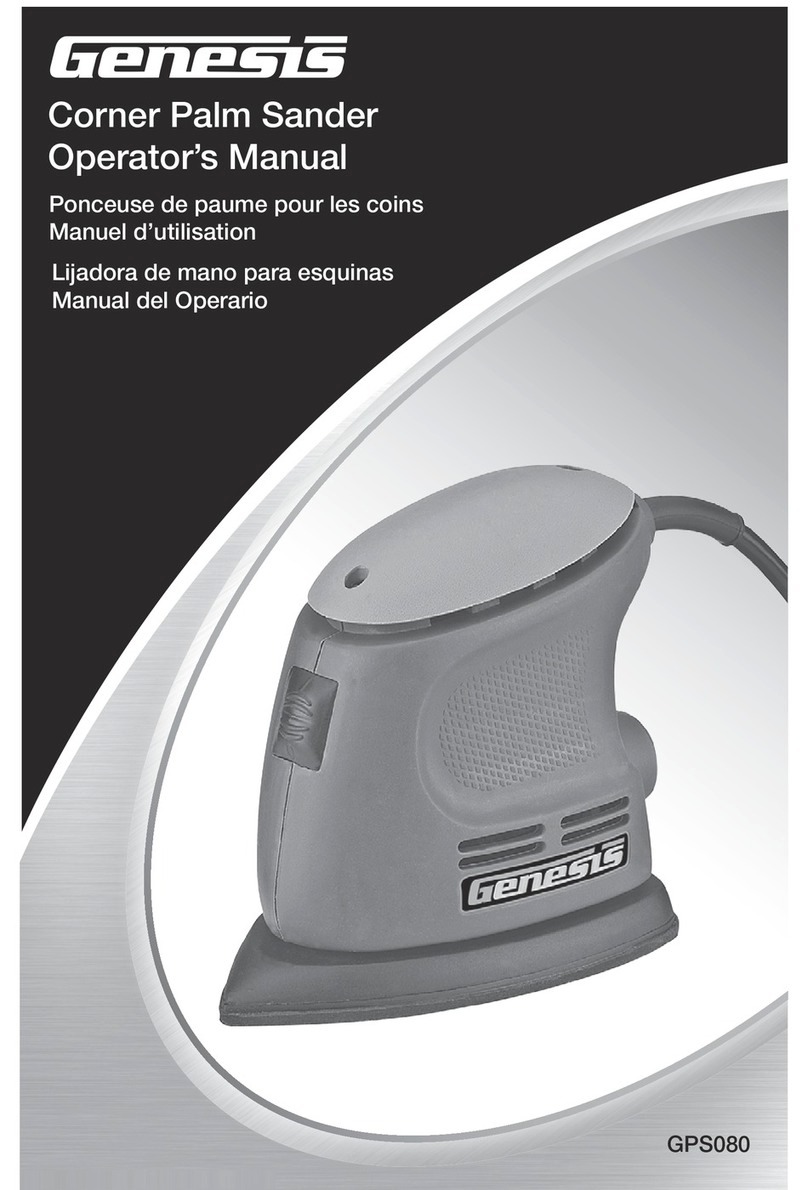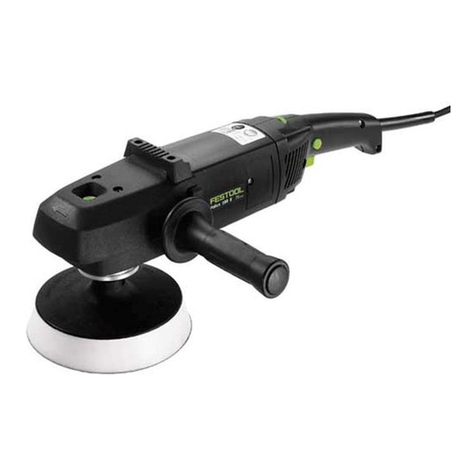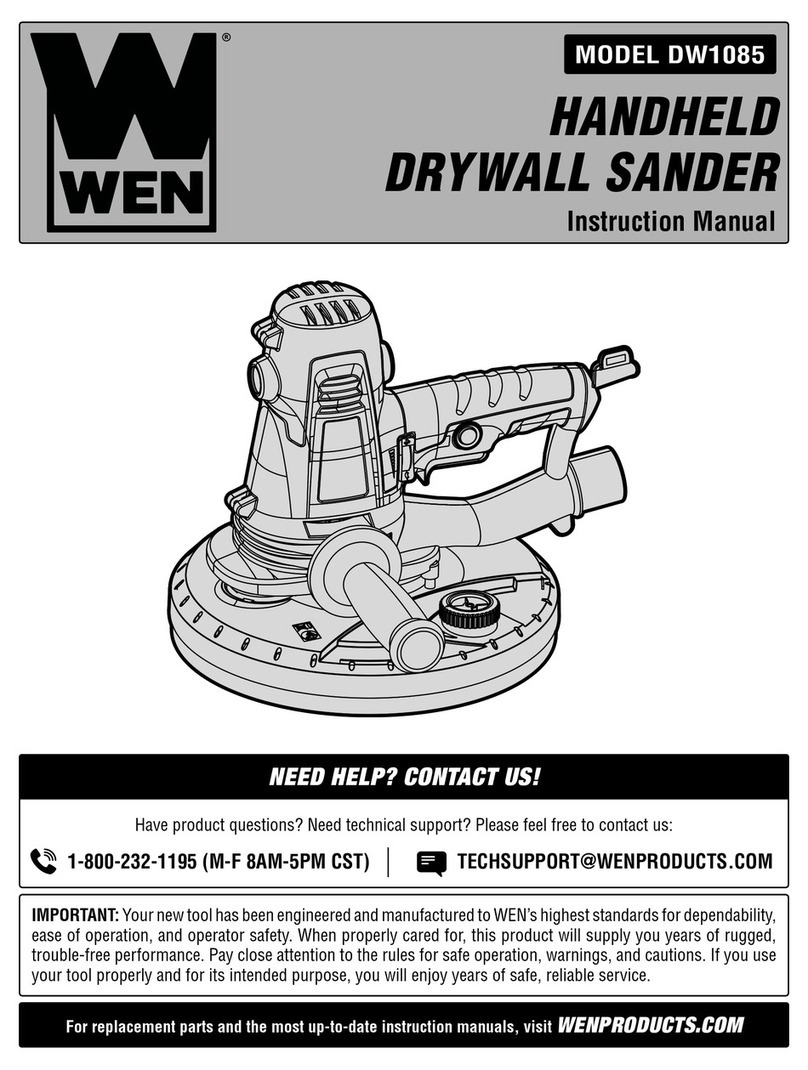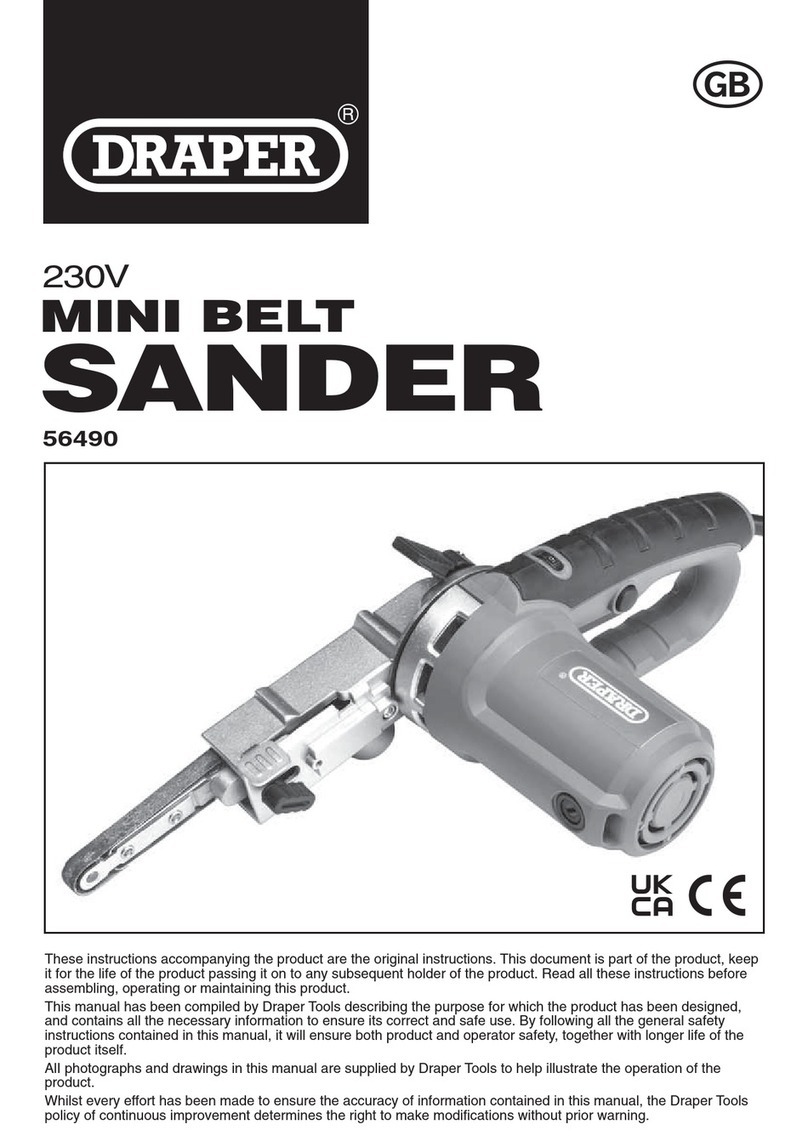HireTech HT8-1.2 System manual

FLOOR SANDER MODEL HT8-1.2
OWNERS MANUAL & OPERATING INSTRUCTIONS
JULY 2003 REF. 179 PART # 163825
PRINTED IN THE UK
© Hiretech
ABC
From Serial Number
07294 (220/240 Volt) & 03415 (110/120 Volt)

NORTH AMERICAN SAFETY INSTRUCTIONS
USE AND APPLICATION
WARNING: This floor sanding machine must be grounded.
This floor-sanding machine shall be grounded while in use to protect the operator from electric
shock. The machine is provided with a three-conductor cord and a moulded three-contact
grounding type attachment plug to fit the proper grounding type receptacle. The Green (or
Green and Yellow) conductor in the cord is the grounding wire. Never connect this wire to other
than the grounding pin of the attachment plug.
This floor-sanding machine is provided with an attachment plug as shown in sketch A. It is
intended for use on a nominal 120 volt circuit. If a properly grounded receptacle as shown in
sketch A is not available, an adaptor as shown in sketch 'C' should be installed as shown in sketch
B if the outlet box that houses the receptacle is grounded. Be sure to fasten the grounding tab with
a metal faceplate screw.
Floor sanding can result in an explosive mixture of fine dust and air. Use floor-sanding machine
only in a well-ventilated area free from any flame or match.
Moving Parts - to reduce the risk of injury, unplug the machine before replacing abrasive sheets
or carrying out any form of adjustment or servicing.
WARNING:
WARNING:
Risk of explosion.
Risk of potential injury.
This machine is intended for commercial use connected with the laying and maintaining of wooden floors and
decks.
These types of surfaces may be found both in commercial and household environments.
ATTACHMENT PLUG SKETCH ‘C’
METAL
SCREW
COVER OF GROUNDED
OUTLET BOX SKETCH ‘B’
ADAPTER
GROUNDING
MEANS
COVER OF GROUNDED
OUTLET BOX SKETCH ‘A’
GROUNDING PIN

CONTENTS
WARNING
MAINS CABLE WIRING - PLUG
SPARE PARTS
SPECIFICATION
SAFETY
SET UP
PREPARATION
OPERATION
FLOOR SANDING TECHNIQUE
FLOOR TYPES
i
i
I
1
1
Assembly and Transport 2
Installing Abrasive Disc 2
2
3
Drum Floor Sander 4
Disc Floor Sander 4
Orbital Floor Sander 4
Hand Sanding 4
Sanding Plank & Strip Floors 4
Veneered, Laminated & Thinner Floors 4
Parquet & Block Floors 5
Between Coats of Finish (Varnish) 5
6
General 7
Visual Inspection 7
Drive Belts 7
Dust Control System 7
Lubrication 7
Care of Motor 7,8
Electrical Testing 9
Sanding Drum 10
11
12,13
14, 15
16
16
17
FLOOR SANDER ABRASIVE GUIDE
SERVICE AND ROUTINE MAINTENANCE
FAULT FINDING
HT8-1.2 PARTS DRAWING
HT8-1.2 PARTS LIST
HT8-1.2 CIRCUIT DIAGRAM
FITTING A REPLACEMENT SWITCH
DECLARATION OF CONFORMITY
SERVICE & REPAIR 18
WARNING
MAINS CABLE WIRING - PLUG
For safe operation of this machine, read and understand all instructions. Look for the ‘warning/caution’ symbol.
This symbol means that if you do not follow the instructions injury can occur to the operator and
damage to the machine and floor may result.
Hiretech reserves the right to make changes or improvements to it's products without prior notice.
®
i
NORTH AMERICA
BLACK
WHITE
GREEN
BRASS
TERMINAL
SILVER
TERMINAL
EU
BLUE BROWN
GREEN/
YELLOW
UNITED KINGDOM
BLUE
(N - NEUTRAL) BROWN
(L - LINE)
GREEN/YELLOW
(E - EARTH)
SPARE PARTS
Use Hiretech genuine spare parts only for service and repair. Use of non-approved parts will void the product
warranty. See the back cover of this manual for the terms and conditions of the Hiretech Limited Warranty.

SPECIFICATION
The HT8-1.2 Hiretech Floor Sander will sand hard
and soft wood floors, cork and composition floors
that require rapid sanding and leveling to a fine
finish. A powerful motor drives a finely balanced
sanding drum which is covered in a unique drum
rubber providing a high quality finish to both hard
and soft woods and other surfaces. Completely self
contained with a high efficiency dust pickup the
machine breaks down into three simple component
parts for easy transport. With low voltage trip and
overload protection the HT8-1.2 is a high
performance sander suitable for professional and
home owner use.
SAFETY
1. For safety it is recommended that a residual
current circuit breaker (ground fault interrupter)
is used with this machine.
2. Check the operating voltage is correct and that
the machine is switched OFF (‘O’) before
connecting to the power supply.
3. Always disconnect from the power supply when
changing the abrasive paper, servicing the floor
sander, replacing the dust bag or leaving the
machine unattended.
4. Always replace the dust bag (paper type) or
empty the dust bag (cloth type) when the dust in
the bag reaches the ‘MAX’ line or when the
machine is left unattended.
5. Never dispose of or empty the contents of the
dust bag into a fire or incinerator.
6. Never reuse the paper dust bag or use a non
standard bag. Cloth bags must be in good
condition with no holes.
7. Always wear a dust mask when using the floor
sander, handling the dust bag or cleaning the
machine after use.
8. Wear ear protection when using the floor sander.
9. Ensure adequate ventilation of the work area to
avoid the formation of a combustible mixture of
flying dust and air.
10. Never smoke when using or servicing the floor
sander or when handling the dust bag.
11. Never expose the machine to rain or damp.
Always store in a dry place.
12. Stop the floor sander immediately if damage to
the machine or abrasive paper is suspected.
13. Never allow the power cable to come into contact
with the sanding drum when the floor sander is in
operation. If the power cable becomes damaged
and the inner conductors are exposed switch the
power OFF and remove the plug before
attempting to move the machine. The cable
must be replaced by an authorised dealer or
qualified electrician using Hiretech® genuine
spare parts only.
14. Keep hands, feet and loose clothing away from
all moving parts of the machine.
15. Punch down or remove all nails, screws, tacks
and other fixings from the floor before sanding to
prevent contact with the sanding drum.
16. Never operate the machine without all the
guards in place.
17. Keep children and pets clear at all times.
18. If the machine should fail to operate refer to the
Fault Finding Guide on page 10.
1
Read the following Safety and Operational
notes before using your Hiretech HT8-1.2
Floor Sander.
Noise: 95 dBa at 1metre (3’ 3")
Switch: Heavy duty low voltage trip
and overload protection.
Motor RPM: 8,500
Drum RPM: 3,300
Guards: Injection moulded ABS.
Drive: Non-slip toothed timing belts
and gear cut pulleys.
Moving Parts: Sealed for life ball bearings.
Weight: 41.5kg (91.5lbs)
0.04 M² H Aeq8
(8 Hr. RMS )
495mm (19.5") total length x
203mm (8") wide sheet with
notched and angled ends 24
to 120 grit.
Abrasive:
Continuous heavy duty AC/DC
self cooling 4 brush.
8" (203mm) wide aluminum
extrusion with moulded rubber
drum cover.
Seated oversize vacuum fan
with adjustable dust pan,
disposable paper dust or cloth
bag.
Sanding Drum:
Dust Pickup:
Vibration:
Motor:
110/120 V 50/60 Hz
220/240 V 50/60 Hz
110/120 V 8A
220/250 V 5A
Average
Load Current:
110/120 V 15A
220/250 V 8A
Power Supply:
Off Load
Current:

SET UP
Assembly and Transport
Installing Abrasive Paper
1. The HT8-1.2 breaks down into three component
parts, the main body, handle assembly and dust
tube for easy handling and transport. To
assemble loosen the Clamp Bracket Ref.21 and
slide the handle assembly into the Handle
Bracket Ref.51. Adjust the height of the handle
so that your arms are slightly bent when standing
upright behind the machine. This will provide
you with maximum control in operation. Tighten
the clamp bracket firmly. Always ensure that the
clamp bracket is tight, check periodically during
use.
2. Connect the Cable Handle Ref.20 to the Body
Twist Lock Ref.24 at the rear right hand side of the
floor sander body. Align the plug with the pins,
push in and twist clockwise to lock.
3. Slide the Exhaust Tube Ref.59 into the Exhaust
Bracket Ref.56 and push fully home.
4. Fit a paper dust bag following the instructions
printed on the bag. If a cloth bag is used ensure
that it is tied securely around the dust tube neck
and that the bag is in good condition with no
holes.
5. To prepare the floor sander for use place the
machine on the floor and remove the main cable
from it's storage position on the handle
assembly. Check that the cable is in good
condition and that all fittings are secure.
6. To dismantle the floor sander reverse procedure
1 to 5 above.
7. Always ensure that the floor sander is secure and
cannot move when being transported in a
vehicle. The floor sander is heavy. Take care
when lifting and carrying the machine.
1. Ensure the power cable is disconnected from the
power supply.
2. Tip the floor sander back so that it rests on the
handle.
3. Lift the Drum Guard Ref.35 and turn the Drum
Ref.168 to expose the Paper Clamp Bar Ref.175.
Take care not to trap your fingers when turning
the drum.
4. Loosen the 2 Paper Clamp Screws Ref.174 with a
coin or suitable screw driver so that the clamp
bar raises about 1/2“ (12mm) only. DO NOT
remove the screws completely.
5. Select a suitable grade of abrasive paper (see
Abrasive Paper Guide on page 5). To help install
course grit abrasive papers draw the smooth side
(back) of the paper over the edge of a work
bench to make it curl .
6. Kneeling in front of the machine place one end of
the abrasive paper under the clamp bar so that
the notches align with the clamp bar screws and
clamp bar.
Carefully holding the abrasive paper in place
rotate the drum 1 revolution. Tuck the other end
of the abrasive paper under the clamp bar and
use both hands to squeeze the sheet tight around
the drum. Make sure it is square to the edges of
the drum with no overlap and both ends of the
abrasive sheet are equal distance under the
paper clamp bar.
Firmly tighten the two clamp bar screws. Check
the abrasive sheet is skin tight around the drum.
If in doubt repeat the above procedure. Loose or
damaged abrasive sheets will tear during
sanding and can be expensive to keep replacing.
Damage may also occur to the floor and floor
sander.
7. Lower the drum guard and stand the machine
up. The floor sander is now ready for use.
Note: Use Hiretech genuine floor sander abrasives
for the best sanding performance and finish. They
will also reduce the risk of tearing due to poor fit
which is a common problem with generic and non
standard abrasives.
1. Where possible remove all furniture from the
area or room. The HT8-1.2 Floor Sander
features an efficient dust pickup, however, some
dust will escape.
2. Remove all tacks, staples and other unwanted
fixings from the floor. Failure to do so will result
in damage to the abrasive paper and sanding
drum.
3. Punch all nails below the surface of the floor
using a suitable nail punch and hammer. Any
screws used to fix boards should be counter sunk
below the surface. During sanding any nails or
screws that become exposed must be punched or
counter sunk further.
4. Firmly fix all loose boards or blocks.
5. Remove heavy wax, grease and dirt deposits by
hand.
6. Sweep and vacuum the floor thoroughly to
remove dirt and discarded fixings.
7. Ensure good ventilation by opening windows.
PREPARATION
2

OPERATION
1. Move the floor sander to the location of your
work.
2. Connect the power cable to a suitable power
supply ideally located behind or to one side of
the machine and work area.
3. Wear a dust mask and ear protection.
4. Hold both handles with the main cable held in a
small loop in the left hand and then passed over
the left shoulder.
5. Apply light downwards pressure on the handles
to tip the floor sander back to raise the sanding
drum off the floor. Switch on by pushing the
ON/OFF switch to the ‘I’ position.
6. Now move the floor sander slowly forward and
at the same time release the pressure on the
handles to gently lower it so that the sanding
drum comes into contact with the floor.
7. Guide the floor sander in a straight line at a slow
walking pace. Do not force or hold the floor
sander back. Allow the machine to do the work
and always move at an even pace.
8. At the end of the pass while still moving forward
tilt the floor sander back so that the sanding
drum comes clear of the floor. Now moving
backwards lower the floor sander again and pull
it backwards over the area just sanded moving at
a steadily even pace. Take care to ensure that
the power cable is kept clear of the sanding drum
at all times. At the end of the sanding pass and
while still moving backwards tilt the floor sander
back so once again the sanding drum comes
clear of the floor.
Move the machine over so that it overlaps the
area just sanded by 3" (75mm) and start to sand
the next pass repeating the above technique.
i. Always ensure that the floor sander is
moving when in operation and the
sanding drum is in contact with the floor.
ii. Never lift the back of the machine when
sanding.
CAUTION - the HT8-1.2 Floor Sander is a
powerful machine. Always ensure that
you have a firm grip before switching on.
CAUTION - to prevent damage to the
floor surface, work piece or machine
follow these rules.
3
iii. Never apply pressure to try to increase the
rate of sanding. Damage to the floor and
machine will occur.
iv. Never bounce or drop the floor sander on
to the floor. Always lower the machine
gently.
v. Never dwell in one place, move steadily at
all times.
vi. Never allow the power cable to come into
contact with the sanding drum.
9. When the dust in the dust bag reaches the ‘MAX’
line stop sanding. Disconnect the power cable
from the power supply and remove the paper
dust bag. Turn the top of the paper dust bag over
to stop the escape of dust and dispose of into a
suitable container. Never reuse the paper dust
bag or empty it or dispose of it into a fire. If a
cloth bag is used empty into a suitable container
being careful to contain the dust. Do not dispose
of the contents into a fire.
10. Fit a new paper dust bag or refit the cloth bag.
Reconnect the floor sander to the power supply
and continue sanding.
11. When taking a break from work disconnect the
power cable from the supply, remove and
dispose of the paper dust bag, or empty the cloth
bag as detailed in 8. above. Never leave the
floor sander unattended with the dust bag in
place containing dust.
12. On completion disconnect the power cable from
the supply. Remove and dispose of the paper
dust bag, or empty the cloth bag as detailed in 8.
above. Stow the cable on the handle assembly
and if required dismantle for transportation.
Carry out maintenance as recommended in
Maintenance and Servicing.
DANGER - never leave the floor sander
unattended with dust in the dust bag.
Always remove the dust bag and dispose
of into a suitable container.

FLOOR SANDING TECHNIQUE
HT8-1.2 Floor Sander (Drum)
HT7-2 Disc Floor Sander (Edger)
HTF-2 Floor Sander (Orbital)
Hand Sanding
- a powerful floor
sander designed for the rapid leveling and sanding of
all types of wood flooring excluding thin laminated or
veneered floors. Load the sander with abrasive
making sure that it is skin tight around the drum.
Loose sheets will tear. Place the sander on the right
hand wall (unless you are making an angled cut on
uneven floors) with about two thirds of the floor in
front of you. Start the sander with the drum off the
floor then walk forward at an even pace and ease the
drum on to the floor. As you near the end of the pass,
gradually raise the drum off the floor. Practice this
technique before turning on the sander.
Cover the same path you made on the forward cut by
pulling the machine backwards and easing the drum
to the floor as you begin the backward pass until you
reach the original starting point, then ease the drum
off the floor.
When two thirds of the floor is sanded, turn the floor
sander around and sand the remaining third in the
same way. Overlap the one third area by 0.6 to 0.9
meters (2 to 3 feet ) with the two thirds area to blend
the two areas together.
- a powerful disc
floor sander designed for sanding along the edges
of a floor without damaging the baseboards or
moldings. Also suitable for smaller areas where the
HT8-1.2 Floor Sander will not reach like stair treads
and closets load the abrasive disc making sure the
retaining bolt is tight. Start the edger with the disc off
the floor then lower the disc to the floor as you move
the sander. Work progressively moving the sander in
a sweeping motion from side to side.
- a orbital action
floor sander designed for re-finishing, sanding
between coats of varnish and re-surfacing floors in
good condition. load the abrasive sheet, pad or strip.
Start the sander, move immediately and sand in the
direction of the grain using the same technique as the
drum floor sander. For difficult to reach areas use the
disc floor sander with a fine grit abrasive, or sand by
hand.
- to sand difficult to reach areas
scrape and sand the floor by hand. Use a scraper to
remove old finishes, always scraping in the direction
of the grain, and then sand by hand using the same
grit abrasive as you finished with when machine
sanding. See Floor Sanding Technique diagrams on
page 5.
WARNING - never bounce the sanding
drum or dwell in one place as this will
sand dips and hollows in the floor.
FLOOR TYPES
PLANK & STRIP FLOORS
VENEERED, LAMINATED & THINNER FLOORS
Old floors in good condition
Uneven floors
Floors with an existing finish
- when the floor is in
good condition - no uneven edges, cupping or
crowning of planks and strips - and you want to re-
surface the floor, sanding back to new wood, start
sanding in the direction of the planks or strips - with
the wood grain. Start with a medium grit abrasive.
Complete the first cut with the HT8-1.2 Floor Sander
then sand up to the baseboards and door thresholds
with the HT7-2 Disc Floor Sander, using a medium
grit abrasive, blending the edges in with the main
floor area. Sweep the floor. Using a medium/fine grit
abrasive, sand the main floor area with the drum
sander and then complete the floor with the edger
using a fine grit abrasive. Sweep the floor. Finish
sanding the main floor area with the drum floor
sander using a fine grit abrasive. If the floor is in
particularly good condition (level with no deep
scratches or blemishes) you may re-surface the floor
using the HTF-2 Floor Sander, however, as the
sanding action of this machine is less aggressive than
the HT81.2 Floor Sander the job will take more time.
- when the floor is uneven sand
diagonally at 45 across the room in both directions
using the HT8-1.2 Floor Sander with a coarse grit
abrasive. Only make one cut on both diagonals, this
will achieve a basic level. Now complete the floor as
for a level strip or plank floor. Use the same grit
abrasive as was used on the 45 cut for the first cut
parallel to the planks or strips.
- when re-finishing a
floor remove as little of the existing surface as
possible. If the old finish is worn and the floor is
generally in good condition use the HTF-2 Floor
Sander with Hiretech abrasive pads and strips which
have been especially designed for re-finishing floors.
These will maintain the integrity of any stain used to
colour the wood and prepare the surface for a new
coat of finish. If the floor is badly marked and
scratched and has to be sanded back to new wood
use the HT8-1.2 Floor Sander and HT7-2 Disc Floor
Sander. Always try a medium grit paper first,
particularly on a diagonal cut. If 90% of the old finish
is removed and the floor is generally leveled, you do
not need to use a coarse grit abrasive.
Use the HTF-2 Floor Sander for veneered and
laminated floors or thinner floors that may have been
subjected to repeated sanding. The HTF-2 will
remove old surface finishes and prepare the floor for
re-finishing. Sand the floor using the same method
as a strip, plank, or parquet floor. If the floor has
deeper scratches or marks these should be sanded
o
o
4

5
out by hand and blended in with the main floor. To
check the wood depth in the floor remove a
baseboard or molding from around the edge of the
floor. This should provide access to the edge of the
floor for inspection.
The grain of the wood will run in a number of
directions so sand the floor in the direction of the
main source of natural light in the room. If there is no
source of natural light sand in the direction of the
longest side of the room or, if the room is square, in
the direction the furniture is laid out and how people
normally use and view the room.
This technique will help mask any imperfections in the
PARQUET & BLOCK FLOORS
floor. Complete the sanding operation as detailed
for plank or strip floors.
Use the HTF-2 Floor Sander to sand between coats of
floor finish, particularly when using water based
varnishes. These types of finishes tend to raise the
wood grain when first applied to raw wood. Allow
each coat of varnish to dry completely following the
manufactures directions. Use Hiretech abrasive pads
to sand between each coat of varnish. The fine
abrasive pads will remove light brush/applicator
marks and raised grain while maintaining the
integrity of the coat of varnish applied
BETWEEN COATS OF FINISH (VARNISH)
unsanded boards sanded boards
level very uneven
floors by sanding
diagonally in both
directions
unsanded boards
unsanded boards
Level uneven floors.
Sand main floor area.
Sand and blend edges in with main floor area.
FLOOR SANDING TECHNIQUE
Plank and Strip Floors
Parquet and Wood Block Floor
- sand in the
direction the boards are laid, with the
wood grain.
-
sand in the direction of the main
source of natural light. If there is no
natural source of light, sand in the
direction of the longest side of the
room. If the room is square, sand in
the direction the furniture is laid out
and how people normally use the
room.
s

6
HT8 FLOOR SANDER & HT7 DISC FLOOR SANDER (EDGER)
Grit 24
Grit 40
Abrasive Paper Grade Floor Type and Condition
Grit 24 Open Coat
Grit 40 Open Coat
Grit 80
Grit 100
Grit 120
For removing surface coatings from old floors such as varnish, stains and
wax polishes. For the rapid sanding and removal of scratches and marks.
Sanding level the joints of sub-flooring like particle board and masonite.
For removing surface coatings from old floors such as varnish, stains and
wax polishes. For the rapid sanding and removal of scratches and light
marks. Sanding level the joints of sub-flooring like particle board and
masonite.
For first sanding of new level wood floors. First sanding after sanding
(Medium) with a drum sander.
Intermediate sanding of all types of wood floor.
(Medium/Fine)
For final sanding of all types of wood floor. First sanding of cork or
(Fine) composition floors. For sanding between coats of solvent based and 2 pack
varnishes.
(Coarse non-clogging)
For the rapid sanding and removal of scratches and marks. Sanding
(Coarse) level the joints of sub-flooring like particle board and masonite.
(Coarse/Medium)
For the rapid sanding and removal of scratches and light marks. Sanding
(Coarse/Medium) level the joints of sub-flooring like particle board and masonite.
FLOOR SANDER ABRASIVE GUIDE
DO NOT OVER-SAND USE ONLY AS HEAVY GRADE ABRASIVE AS IT TAKES TO DO THE
JOB. PROGRESS FROM FIRST GRADE USED THROUGH FOLLOWING GRADES TO
REMOVE ALL VISIBLE SANDING MARKS. DO NOT MISS A GRADE.
FLOOR SANDER ABRASIVES
24 Grit Open Coat 01001 - - - -
24 Grit 01002 01026 01044 - -
40 Grit Open Coat - - - - -
40 Grit 01003 01027 01045 01750 -
60 Grit - - - 01751 -
80 Grit 01004 01028 01046 01752 -
100 Grit - - - - -
120 Grit 01005 01030 01048 01754 -
180 Grit - - - - 01756 -
Abrasive Pad 280G/Backing Pad - - - - 01769
HT8/DU8
FLOOR SANDER
SHEET
50/CASE
HT7/SUPER 7
EDGER DISC
FIBRE BACKED
25/CASE
HT7/SUPER 7
EDGER DISC
PAPER BACKED
25/CASE
HTF
FLOOR SANDER
SHEET
ADHESIVE BACKED
50/CASE
HTF
ABRASIVE PAD
20/CASE
Hiretech Abrasive Product Range
Hiretech recommend the following
abrasive range which are suitable
for all floor types and applications.

SERVICE & ROUTINE MAINTENANCE
CAUTION - maintenance and repairs
must be carried out by authorised
personnel only. To prevent injury, always
remove the power cable from the power
supply before undertaking any work on
the machine. Do not operate the floor
sander unless it is fully assembled and all
guards are in place. Use Hiretech
genuine spare parts only.
General
Visual Inspection
1. Always make a list when first examining the
machine, to remind you of parts or action
needed on completion of repair/service.
2. The HT8-1.2 is subject to high speeds. All screws
should be fitted using a suitable thread lock
compound.
3. On completion of any work or service on an
electrical tool or appliance statutory safety tests
must be carried out by a competent person and
recorded (see Testing for Electrical Safety page
8).
4. The HT8-1.2 needs no lubrication during routine
servicing.
5. Always ensure that the electrical supply is
disconnected before starting any routine
servicing or repair.
1. Check that the drum guard Ref.35 is in good
condition and functioning correctly. Ensure that
the Warning Label Ref.36 is present and legible.
2. Check all other guards and mechanical parts are
in good condition.
3. Examine the power cable Ref.39 and the handle
cable Ref.20. If the outer insulation shows the
slightest of abrasions or the inner conductors are
exposed, then the cable must be replaced. The
cable must not be repaired with tape or
insulation sleeve
4. Examine both the mains plug and the
interconnecting socket, Body Twist Lock Ref.24.
The plugs must be opened and examined (see
Electrical Testing page 8).
5. If a cloth type bag is in service check the
condition, old clogged cloth dust bags make for
an inefficient dust pickup.
6. Ensure that all labels are present and in good
condition.
Drive Belts
Dust Control System
Lubrication
Care of Motor
1. To examine the condition of the Drive Belts
Ref.164 and Ref.165 remove the four screws
Ref.83 and the Belt Guard Ref.81.
2. Lift the Fan Belt Ref.165 while rotating the pulley
remove the fan belt. Repeat for the Drum Belt
Ref.164.
3. Examine the pulleys for wear, worn or damaged
pulleys should be replaced
4. To reduce the instance of belt breakage, examine
the drive belts, look for cracks or fraying and
replace if necessary with new belts. To replace
reverse the above procedure taking care to avoid
bending the belts tighter than the pulley diameter
as this can result in damaged belts. Refit the belt
guard.
1. For efficient dust pick up ensure that cloth type
dust bags are clean and unclogged and that the
intake is clear and properly adjusted.
2. Turn the machine on to its side and loosen the
three Screws Ref.71 and remove the Dust Shoe
Ref.72 and clear any obstruction. The grit from
the abrasive paper can wear away the leading
edge of the dust shoe, if this has occurred then
file or grind the leading edge level before
refitting.
Install the dust shoe ensuring that the clearance
between the shoe and the drum is maintained at
3/8“ (10mm).
1. The HT8-1.2 is completely lubricated. The
bearings are sealed and do not require
lubrication. In the unlikely event that a bearing
requires replacement use a Hiretech genuine
spare part only as the grease contained in these
bearings is special. A standard bearing is not
suitable and may result in further damage.
1. The motor must be kept free from grease and
dust.
2. The motor brushes must be checked regularly,
inspect the brushes every three months or every
500 hours of use, whichever comes first.
3. Replace ALL FOUR motor brushes when any one
brush has worn to 12mm ( / ”) or less in length.
Brushes MUST slide freely in the brush holders.
CAUTION - take care to avoid trapping
your fingers when removing or replacing
the drive belts.
15
32
7

4. To inspect and replace motor Brushes Ref.104,
with the brush block assembly removed.
i. Remove the three Screws Ref.82 and
remove the Wall End Guard Ref.84 to
expose the motor brush assembly.
ii. Remove the four retaining Screws Ref.31
from the Shield Wall End Ref.30, insert two
of the screws into the ‘jacking holes’
situated adjacent to the countersunk
retaining holes.
iii. Carefully tighten these screws until the
shield wall end is jacked clear of the outer
casting. Withdraw the shield-wall end.
iv. With the brush block assembly complete
and the connecting leads still attached.
You will note that as the brush block
assembly is withdrawn the brushes spring
towards the center and often the brush
springs fall clear as the brushes are no
longer at the height to retain them. Take
care not to lose any springs.
v. To remove a brush spring with a brush in
the operating position push the brush
spring down and towards the brush and lift
out.
vi. Using a cross recess screwdriver remove
the four brush shunt (pigtail) retaining
Screws Ref.105 and lock Washers Ref.100.
vii. Remove the four brushes. Remove the two
‘jacking’ screws.
viii. Thoroughly clean the brush assembly and
housing using a soft brush and a suitable
vacuum cleaner.
ix. Inspect the four brushes for damage or
wear and if any one brush is found to be
damaged or worn to a length of 5/8“
(16mm) or less in length then replace all
four brushes.
x. When replacing brushes ensure free
movement in each brush holder and fit the
brush with the shunt (pigtail) towards the
field coil. Ensure that each brush shunt is
connected securely with the screw, and
lock washer, two spare screws and lock
washers are provided with each pack of
brushes. Do not fit the brush springs at this
stage.
xi. Pull each brush up to the top of the holder
using the shunt wire to retain it in this
position for the next stage.
xii. Enter the assembly into the main frame
taking care to avoid contact between the
brushes and the commutator of the
armature, that the shield wall end is
correctly aligned with the main frame and
that no leads are trapped. There is a
depressed pattern on the shield wall end
and on the main frame to assist alignment.
Both the bearing fit and the main frame fit
are ‘light contact’ and may require lightly
tapping into position using a soft mallet.
DO NOT FORCE.
xiii. Replace and tighten the four countersunk
Screws Ref.31.
xiv. Remove the four brush block retaining
Screws Ref.31 and the single timing Screw
Ref.34 from the Shield-Wall End Ref.30.
The brush block assembly is now free to
rotate. To fit the brush springs rotate the
brush block assembly counter clockwise
(over towards the rear of the machine) until
the lower brush holder is accessible, fit the
brush spring by inserting into the holder
with the coil spring over the brush then
push down until the tag comes into contact
with the holder, slide the tag away from the
brush and release. The brush spring will
clip into position. Check the spring and
brush for correct alignment and free
movement.
xv. Rotate the brush block assembly clockwise
and repeat to fit the remaining three
springs. The switch and field cables
restrict the movement of the brush block
assembly, take care not to loosen or
damage these cables.
xvi. Return the brush block assembly to its
original position and align the timing
notch in the block with the timing hole,
screw the timing Screw Ref.34 into
position.
xvii. Secure the brush block assembly using the
remaining four screws Ref.34. DO NOT
OVER TIGHTEN.
xviii. Finally check that all cables are well clear
of moving parts before refitting the guard
wall and securing with the 3 Screws
Ref.82..
Note: To inspect and replace the motor brushes while
retaining the brush block assembly in place repeat
the procedure xiv. to xviii. above.
8

Electrical Testing
CAUTION - testing for electrical safety
should be undertaken by a competent
person and all results recorded. Do not
exceed 1250 volt insulation test duration
of 3 seconds.
1. Examine the power cable and handle cable for
damage, if the outer insulation shows more than
the slightest of abrasions or the inner conductors
are exposed then the cable must be replaced.
The cables must not be repaired with tape or
insulation sleeve.
2. Open and check mains plug and interconnecting
socket Ref.24 for condition, loose connections,
damaged wires etc. Ensure that the strain relief
of the power cable plug is correctly secured to the
outer cable insulation.
3. Open and examine the Switch Housing Ref.11
for loose connections, damaged wires, and
general condition. Pay special attention to any
gaskets, 'O' rings and seals intended to exclude
dust from the switch and switch housing area,
these must be maintained in good condition.
4. Ensure that the Strain Relief Ref.5 is correctly
secured to the outer cable insulation.
Note: HT8-1.2 Floor Sanders manufactured from
October 1993 starting with Serial Number 00532
(110/120V) and 00779 (220/240V) feature a fully
protected circuit breaker which incorporates 'Low Volt
Protection'. This means that should the mains supply
be interrupted during use the switch will immediately
return to the 'OFF' position to protect the operator.
This feature, by preventing a circuit through the switch
unless mains voltage is present, also prevents a full
insulation (flash) test unless the test instrument has
' ' facility.
If your instrument has this facility then:- replace the
switch cover 'A' taking care to avoid trapping leads
and ensuring that all dust gaskets are correctly
positioned. Check that the circuit breaker 'ON'
button does not lock in the 'ON' position when
depressed. The button must only lock 'ON' when
current is present. Before carrying out test ensure that
the motor is connected by the twist lock socket Ref. 24
and that all safety measures have been taken.
(Class 1 Earthed Appliance [U.K.] ) Carry out 'test on
run' procedure.
If your instrument does not have 'test on run' facility
then Continue as follows:-
5. While you have the switch housing open for
visual inspection remove the circuit breaker
cover 'B' together with the 'low volt coil 'C'(see
below). Do not disconnect or disturb any cables.
The 'low volt coils will remain within the cover 'B'.
The circuit breaker will now lock into the 'ON'
position without current present. Before carrying
out an insulation (flash) test ensure that the motor
is connected by the twist lock socket Ref. 24 and
that all safety measures have been taken.
test on run
9
HT8-1.2 Low Voltage Switch.
CE 0 U AC690V CSN EN 60947
START
STOP
6
4
2
?? ??-??A
TEST
AC 3
SM1-10
5
OEZ
3
1
Cover 'B'
Low Volt Coil 'C'
stays within cover
Gasket
Cover 'A'
Dust Membrane

6. Using standard procedure test for electrical
safety (Class 1 Earthed Appliance [U.K.] ). Do
not exceed 1250 volt flash duration of 3 seconds.
7. Record the test results.
8. Complete a functional (run) test and record
results.
9. After carrying out the tests disconnect the
machine from the test station and snap the 'Low
Volt Coil' 'C' back into position and replace cover
'B'.
10. Replace the switch cover 'A' taking care to avoid
trapping leads and ensuring that all dust gaskets
are correctly positioned. Check that the circuit
breaker 'ON' button does not lock in the 'ON'
position when depressed. The button must only
lock 'ON' when current is present.
11. Finally test the machine once again to ensure
good earth and insulation of the mains cable
and switch. Do not exceed 1250 volt flash
duration of 3 seconds.
1. Check that power supply is disconnected. Tilt the
machine back and rest the handle on the floor.
Open the drum guard and examine the drum
cover. A damaged or worn cover must be
replaced to maintain machine performance. A
damaged or worn cover can result in poor
sanding with subsequent damage to the floor
surface and can be dangerous in operation. A
cover that is worn to 1/4“ (6mm) or less in
thickness must be replaced.
2. To replace the drum cover see the detailed
instructions included in each genuine Hiretech®
Drum Cover Kit Ref.167 Part # 162312. The use
of an impact screwdriver may assist.
3. It is recommended that at each service interval
the drum cover is checked and trimmed
(dressed) if necessary to provide a true uniform
diameter.
4. First check that the rear castors are properly
adjusted. Remove the 4 Screws Ref.83 and the
Belt Guard Ref.81. Check that the factory mark
is present and aligned on the rear castor adjuster
Ref.64 and main frame. Adjust as necessary by
loosening the two clamp Bolts Ref.65 and
adjusting the cam.
CAUTION - when undertaking a
functional test ensure that the machine is
secure, remember the sanding drum will
rotate, ensure that the drum cannot come
into contact with the work bench/service
area.
Sanding Drum.
10
If the machine has no factory mark on the
adjuster and main frame then it is a later type
machine that uses a concentric support instead
of an adjuster. No adjustment is required.
5. Fit a sheet of fine grit abrasive paper (120 grit),
abrasive side up on to a level floor surface.
Remove any abrasive paper from the drum and
re-tighten the clamp bar screws. Make sure the
clamp bar screws are tight.
Position the floor sander over the abrasive paper
and connect the power cable to the power
supply. Tip the floor sander back to raise the
sanding drum off the floor and switch on.
Gently lower the floor sander so the sanding
drum 'just' touches the abrasive paper. Hold the
sander in position for a few seconds then tip back
and switch off.
Disconnect the power cable and tip the floor
sander back so that it rests on it's handle. Lift the
drum guard and check the condition of the drum
cover. If it is uniform an even surface will be
witnessed, if not, continue to dress the drum until
all high and low spots are removed. Take care
not to remove too much material as this will
reduce the life of the drum cover.
6. When a uniform surface is achieved it is
advisable to slightly ‘feather’ both edges of the
drum cover. Switch off and disconnect the power
cable from the power supply. Tilt the machine
back and lift the drum guard to expose the drum
cover. Using a medium to fine grit abrasive
paper carefully feather the edge of both sides of
the drum cover by holding the abrasive paper
against the edge and rotating the drum. Be
careful not to trap your fingers. The softer edge
provided will help prevent ‘cut’ lines witnessed
on the floor surface when sanding particularly in
softer woods. Always feather the edges of a new
drum cover.
Note: On earlier models the line stamped on the
adjuster and main frame has been set in the factory at
the time of manufacture. Never change, deface or
alter this line.
WARNING - the sanding drum and drum
cover must be correctly adjusted and
maintained to ensure the best sanding
performance. Failure to do so can result
in damage to the floor surface and can
be dangerous.

11
FAULT FINDING
FAULT CAUSE ACTION
The machine does not run. The power cable is not Connect the power cable to the
connected to the power supply. power supply.
The overload protection has Allow to cool, switch on.
been activated.
The motor brushes are worn. Replace the motor brushes.
The voltage is too low. Check main power supply
complies with the machine
serial plate data.
The overload protection The drum motor is stopped. Contact an authorised repair
activates frequently. agent.
A bearing has failed. Contact an authorised repair
agent.
The voltage is too low. Check the main power supply
complies with the machine's
serial plate data.
The pressure on the Fit a finer grit abrasive paper,
sanding drum is too high. make sure the voltage is
correct.
The sanding drum will not Disconnect from the power and
rotate. check the sanding drum for
obstruction. If overload still
operates contact an authorised
repair agent.
The machine will not pick-up dust. The dust bag is full. Replace the dust bag.
The dust shoe is out of Adjust the dust shoe.
adjustment.
There is an obstruction in Remove the dust shoe and
dust pickup. check for obstruction.
Clear as necessary.
The fan belt has broken. Replace the fan belt.
The machine does not sand The drum cover is not round. Redress or replace the drum
evenly. cover.
The Floor Roller assembly Adjust the Floor Roller
(adjustable type) is out of a
The Floor Roller assembly is Repair/replace the Floor Roller
worn or damaged. Assembly.
The machine is not being Read ‘Operation’ section of
operated properly. this manual.
The sanding drum will not rotate. The drum belt is broken. Replace the drum belt.
The drum bearing has failed. Contact an authorised repair
agent.
The shear pin Ref.144 has Contact an authorised repair
operated. agent.
There is an obstruction. Disconnect from power supply
and clear the obstruction.
ssembly see page 11.4
adjustment.

12
FLOOR SANDER MODEL HT8-1.2
39
7
11
10
14
19
15
16
26
21
17
17
18
49
20
59
55
24
51
52
53
50
96
53
56
67
60
65
66
64
63
61
62
83
81
75
2
78
86
73
72
36
35
28
80
79
29
84
82
77
86
74
58
54
23
9
1
23
4
48
46
22
12
6
5
8
127 85 49 47
25
200
57
201
{

13
FLOOR SANDER MODEL HT8-1.2
142
143 124
145
144
146
149
98
173
176
174
175
174
167
250
127
152 124
126
159
101
103
102
168
169
165
164
179 180
31
30
140
109
104 100
117
115
116 119
121 119
123
86 127
125
128
126
130
97
101
103
102
129
110
43
96 113
125
111 114
118
98
34
OWNERS WORKSHOP MANUALOWNERS WORKSHOP MANUAL
NOVEMBER2000NOVEMBER2000 REF.180 PART # 163825REF.180 PA RT # 163825
PRINTEDINTHEUK
PRINTEDIN THE UK
FLOOR SANDER
MODEL HT8-1.2, HT8-1 & DU8R
FLOOR SANDER
MODEL HT8-1.2, HT8-1 &DU8R
FLOOR SANDER
MODEL HT8-1.2
FLOOR SANDER
MODEL HT8-1.2
OWNERS MANUAL & OPERATING INSTRUCTIONSOWNERS MANUAL &OPERATING INSTRUCTIONS
From Serial Number
03415 - 110/120 Volt
07294 - 220/240 Volt
From Serial Number
03415 -110/120 Volt
07294 -220/240 Volt
NOVEMBER2000NOVEMBER2000 REF.179 PART # 163825REF.179 PART # 163825
PRINTEDIN THE UKPRINTEDIN THE UK
98
99
92 91
96 95
93
170
62 89 88
87 62
93 96
97 102
103
86
94
HIRETECH
SERVICE TOOL

14
HT8-1.2 PARTS LIST
1 962308 1 Screw
2 980652 2 Washer
3 162019 1 Clamp Handle
4 163907 1 Handle Cross
5 101205 1 Strain Relief
5 163691 1 Strain Relief (NA)
6 101206 1 Nut Lock
7 163849 1 Dust Cover Kit
8 163837 1 Bracket Switch Mounting
9 163839 1 Switch 110/120V
9 163843 1 Switch Conversion Kit 110/120 Volt
9 163848 1 Switch 220/240V
9 163851 1 Switch Conversion Kit 220/240 Volt
10 163870 1 Gasket Switch Housing
11 163840 1 Cover Switch
12 163838 2 Screw
14 163871 4 Screw
15 163737 1 Handle Assembly Complete 240 Volt (UK)
16 169012 1 Tube Handle
17 980615 2 Washer
18 101220 1 Strain Relief Handle Cable
18 163804 1 Strain Relief Handle Cable (NA)
19 164508 1 Hook Cable
20 100337 1 Cable Handle
20 163782 1 Cable Handle 110 Volt (UK)
20 519510 1 Cable Handle (NA)
21 960180 1 Clamp Handle Bracket
22 960183 1 Bracket Handle Cross
23 911045 1 Base Twist Lock
24 911046 1 Body Twist Lock
25 163867 1 Lead Earth Base Twist Lock
26 163808 1 Grommet
28 165103 1 Label 'Lift Here & At Rear' (Metal)
29 163201 1 Main Frame
30 167804 1 Shield Wall End
31 962084 4 Screw
34 962204 5 Screw
35 163795 1 Guard Drum Assembly (Grey)
36 121252 1 Label Guard Drum
39 163683 1 Cable Main Assembly 220 Volt (EEC)
39 163684 1 Cable Main Assembly 240 Volt (AUS)
39 163685 1 Cable Main Assembly 110 Volt (UK)
39 519501 1 Cable Main Assembly 110 Volt (NA)
39 908285 1 Cable Main Assembly 240 Volt (UK)
43 010200 4 Washer
46 163906 1 Handle Single Grip
47 980197 1 Washer
48 962402 1 Bolt (including nut)
49 920148 1 Nut
50 167308 1 Ring Retaining
51 160815 1 Bracket Handle
52 980196 1 Washer
53 962244 5 Bolt
54 163796 1 Bag Dust Cloth
55 163823 1 Retainer Dust Bag Disposable
55 163826 6 Retainer Dust Bag Disposable
56 160809 1 Bracket Exhaust
57 163403 1 Gasket Exhaust
58 07037 25 Disposable Paper Dust Bag HT8 Pack 2
(box 25)
58 07039 50 Disposable Paper Dust Bag HT8 (box 50)
59 163790 1 Tube Exhaust (Grey)
60 167708 1 Shaft Floor Roller
61 169704 2 Roller Floor Assembly (with bearing)
62 902567 4 Bearing (Fan & Floor Roller)
63 467308 4 Ring Retaining
64 160504 1 Adjuster Floor Roller
65 962139 2 Bolt
66 980646 2 Washer
67 962103 1 Screw
72 167902 1 Shoe Intake
73 163636 1 Cover Inlet
74 167404 1 Rod Drum Guard
75 920256 1 Nut
77 980629 1 Washer
78 169504 1 Weight Balance
79 962409 1 Screw
80 962170 1 Screw
81 163791 1 Guard Belt (Grey)
82 163814 3 Screw
83 163869 4 Screw Guard Belt
84 163792 1 Guard Wall End (Grey)
85 980623 2 Washer
86 962109 8 Screw
87 167312 1 Ring Retaining
88 164202 1 Housing Fan
89 168203 1 Spacer Fan Bearing
90 163813 2 Screw
91 008212 1 Spacer Fan
92 163004 1 Fan Intake
93 162021 2 Clamp Bearing
94 167608 1 Seal fan
95 167210 1 Retainer Seal
96 010210 4 Screw
97 166906 2 Pulley Fan
98 915028 6 Key
99 167704 1 Shaft Fan
100 010220 4 Screw and Washer Set
101 980648 2 Washer
102 980626 3 Washer Lock
103 920132 3 Nut
104 010180 4 Brush Motor
105 962003 4 Screw
110 911662 1 Lead Motor Assembly
111 167302 1 Ring Retaining
113 168104 1 Sleeve
Ref. PSTK Pack Description
Qty. Ref. PSTK Pack Description
Qty.

HT8-1.2 PARTS LIST
114 163104 1 Field 110/120 Volt HT8
114 163112 1 Field 220/240 Volt HT8
115 962401 2 Screw
116 166172 1 Baffle Motor
117 167204 1 Retainer Baffle
118 160408 1 Armature 110/120 Volt
118 160412 1 Armature 220/240 Volt
119 980004 2 Spacer
121 163008 1 Fan Motor
123 167802 1 Shield Pulley
124 902550 2 Bearing Drum Shaft
125 163682 2 Bearing Armature
126 062003 2 Clamp Bearing
127 962345 10 Screw
128 168212 1 Spacer Motor Pulley
129 163304 3 Flange Pulley
130 166909 1 Pulley Motor
140 163789 1 Brush Block Assembly
142 962411 1 Screw
143 162006 1 Clamp Bearing
144 925113 1 Pin Drum Shaft
145 161108 1 Bush Bearing
146 168206 1 Spacer Bearing
149 167716 1 Shaft Drum
152 168209 1 Spacer Bearing
159 166916 1 Pulley Drum
164 903260 1 Belt Drum 3/4" (19mm) Wide
15
Ref. PSTK Pack Description
Qty. Ref. PSTK Pack Description
Qty.
165 903273 1 Belt Fan 1/2" (13mm) Wide
167 162312 1 Drum Cover Kit
168 162532 1 Drum Assembly Complete
169 100327 13 Screw
170 163012 1 Assembly Fan Intake
173 163668 1 Lifting Pin Assembly
174 000920 2 Screw Clamp Bar (screwdriver slot)
174 163657 2 Screw Clamp Bar (coin slot)
175 020045 1 Clamp Bar Paper (reversible)
176 164607 3 Insert Drum Kit
179 163825 1 Owners Manual & Operating Instructions
200 101219 1 Floor Roller Assembly
201 163827 1 Kit Moulded Guards (Grey)
201 163873 1 Kit Moulded Guards (Grey, excl. Tube Exhaust)
250 011860 2 Service Tool - Extractor Seal
250 100325 1 Service Tool - Clamp Drum Cover
250 163822 1 Service Tool - Drum Insert Removal
250 163857 1 Service Tool - Adjuster Floor Roller
250 163865 1 Service Tool - Locking Drum
250 024500 1 Test Lead
The following items are not illustrated.
Special Tools

16
HT8-1.2 CIRCUIT DIAGRAMimited
ARMATURE
FIELD
FIELD CABLE
CABLE REF. 39
21
43
65
U/V
O/C
CABLE REF. 20
SWITCH
UNDER VOLTAGE AND OVERLOAD PROTECTED
NOTE: TERMINALS3&4NOTUSED
U/V COIL LEADS
GREEN/YELLOW (GREEN - N. AMERICA)
BROWN (BLACK - N. AMERICA)
BLUE (WHITE - N. AMERICA)
FITTING A REPLACEMENT SWITCH
24 6 24 6
INSTRUCTION FOR NORTH AMERICA INSTRUCTION FOR EEC, AUS, NZ
CE () U. AC960V CSN EN 60947T-4-1 CE () U. AC960V CSN EN 60947T-4-1
OEZ OEZ
11
STOP START STOP START
I. ??-??A I. ??-??A
TEST TEST
AC 3 AC 3
SM1-10 SM1-10
55
33
Latch top
then push down
and back to secure
Latch top
then push down
and back to secure
Ground terminals
do not disconnect.
Ground terminals
do not disconnect.
Connect black conductor
and U/V lead.
Connect brown conductor
and U/V lead.
Connect black conductor. Connect brown conductor.
Connect white conductor. Connect blue conductor.
Connect white conductor
and U/V lead.
Connect blue conductor
and U/V lead.
Motor Lead Motor Lead
Mains Lead Mains Lead

17
DECLARATION OF CONFORMITY
This declaration identifies the product, manufacturer's name and address, and applicable specifications
recognised in the European community.
DECLARATION OF CONFORMITY
Manufacturer's Name:
Manufacturer's Address:
declares that the product:
Product Name:
Model Name:
conforms to the following:
following the provisions of the directives:
electrical safety test procedures comply with:
Hire Technicians Group Ltd.
Chalk Hill House
8 Chalk Hill
Watford
Herts WD1 4BH
Hiretech Floor Sander
HT8-1.2 230 Volt 50Hz Insulation Class 1
HT8-1.2 110 Volt 50Hz Insulation Class 1
Machinery Directive (Harmonised) 89/392-EU as amended
Low Voltage Directive (Harmonised) 73/23/EU as amended
Electromagnetic Compatibility Directive 89/336/EU as amended
89/392/EU, 93/44EU, 73/23/EU, 93/68/EU/89/336/EU, 91/368/EU,
92/31/EU
EN60 335-1-88 (HD 251-1-3) BS 3456-201 EN292-1-91
EN292-2-91 EN60204-1-92
EN55014-93 (BS 800) EN 50082-1-92
IEC 745-2-4 (HD 400.2) (BS 2769-2-2.4)
IEC 335 pt. 1-2, HD251 1-3 1982, BS 2769 & 3456, CSA C22.2,
KEMA K78A1/W1 & W3, NEMKO 503./89, DIN VDE 0700 1/04.88
HD 264.S2 15/07.86
Where the product is licensed to carry a National Approval Mark it is
certified that all such products comply with the terms of that license.
C.J. Hedger, Director of Engineering. 1 July 2003
Other manuals for HT8-1.2
1
Table of contents
Other HireTech Sander manuals
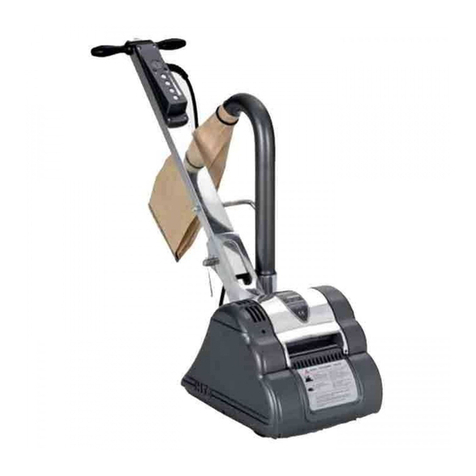
HireTech
HireTech HT8 System manual
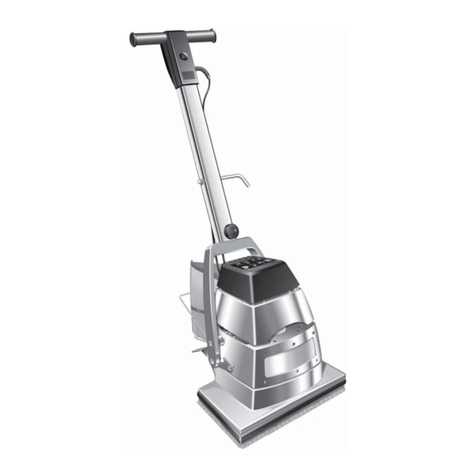
HireTech
HireTech HTF System manual
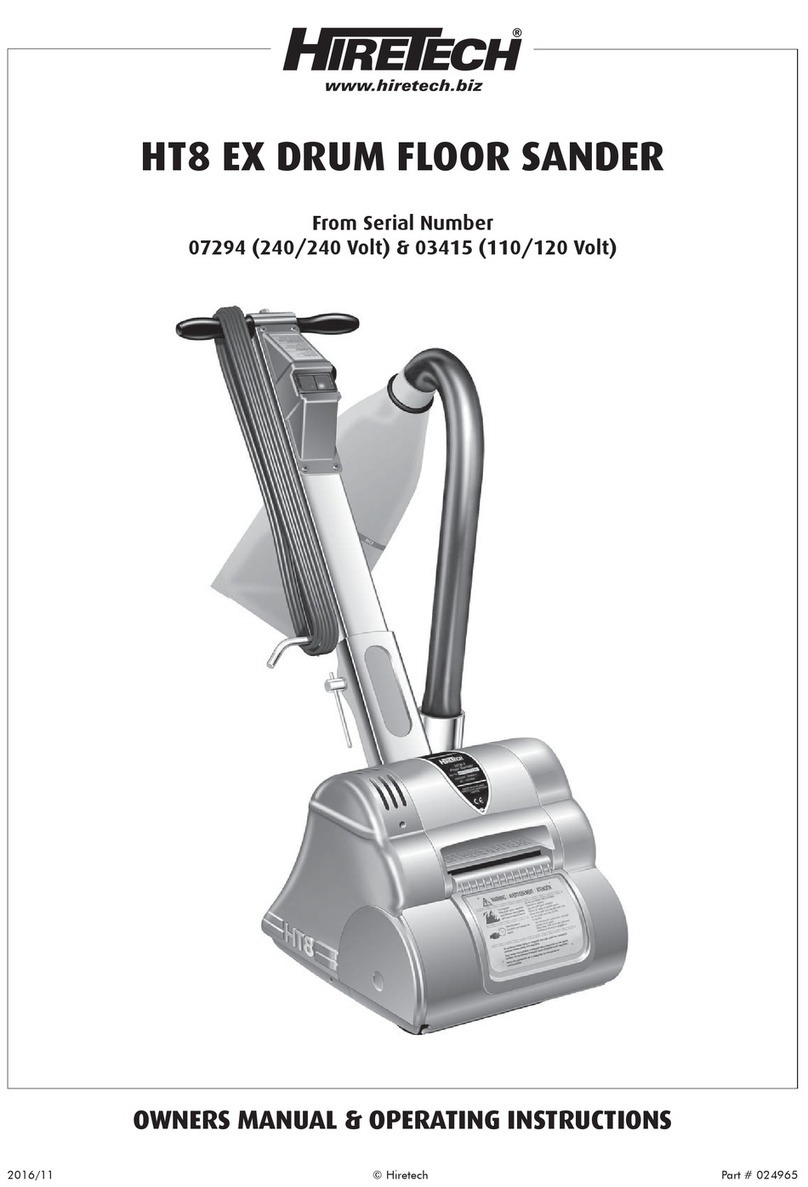
HireTech
HireTech HT8 EX System manual
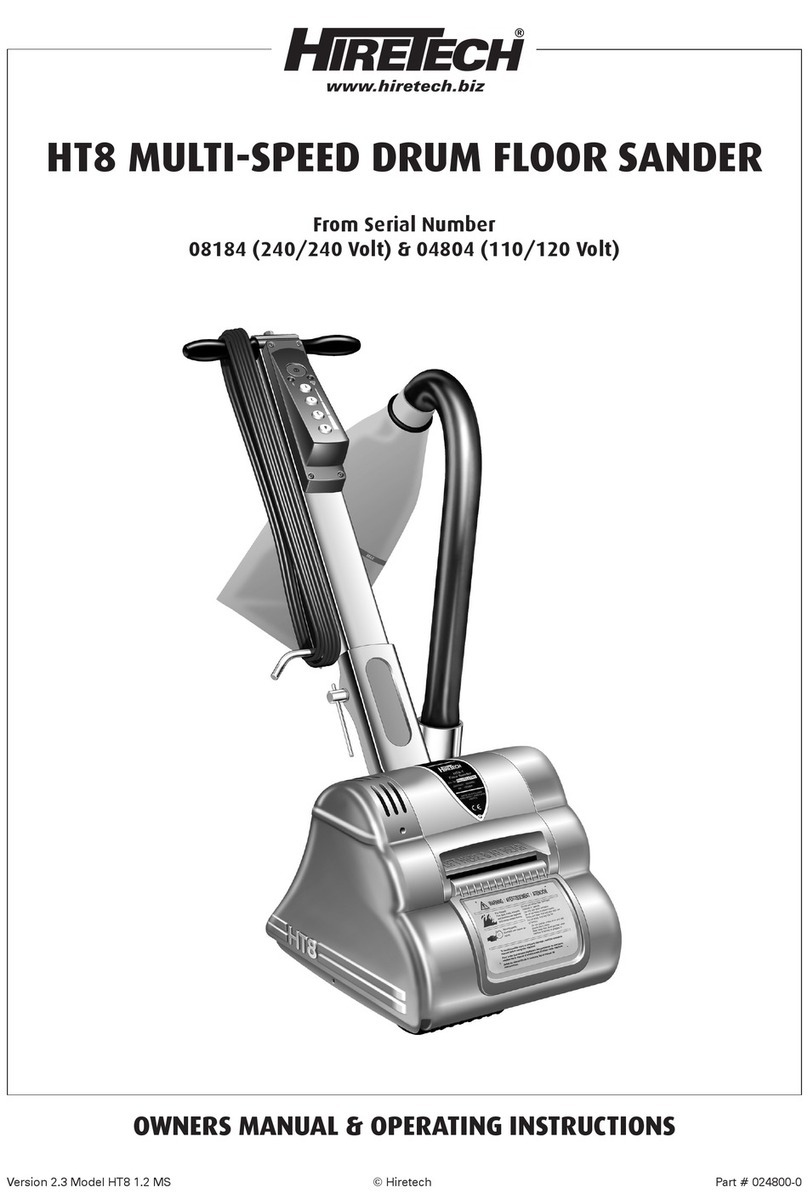
HireTech
HireTech HT8 System manual

HireTech
HireTech HT8 System manual

HireTech
HireTech HT7-2 System manual

HireTech
HireTech HT8 System manual

HireTech
HireTech HT8 EX User manual
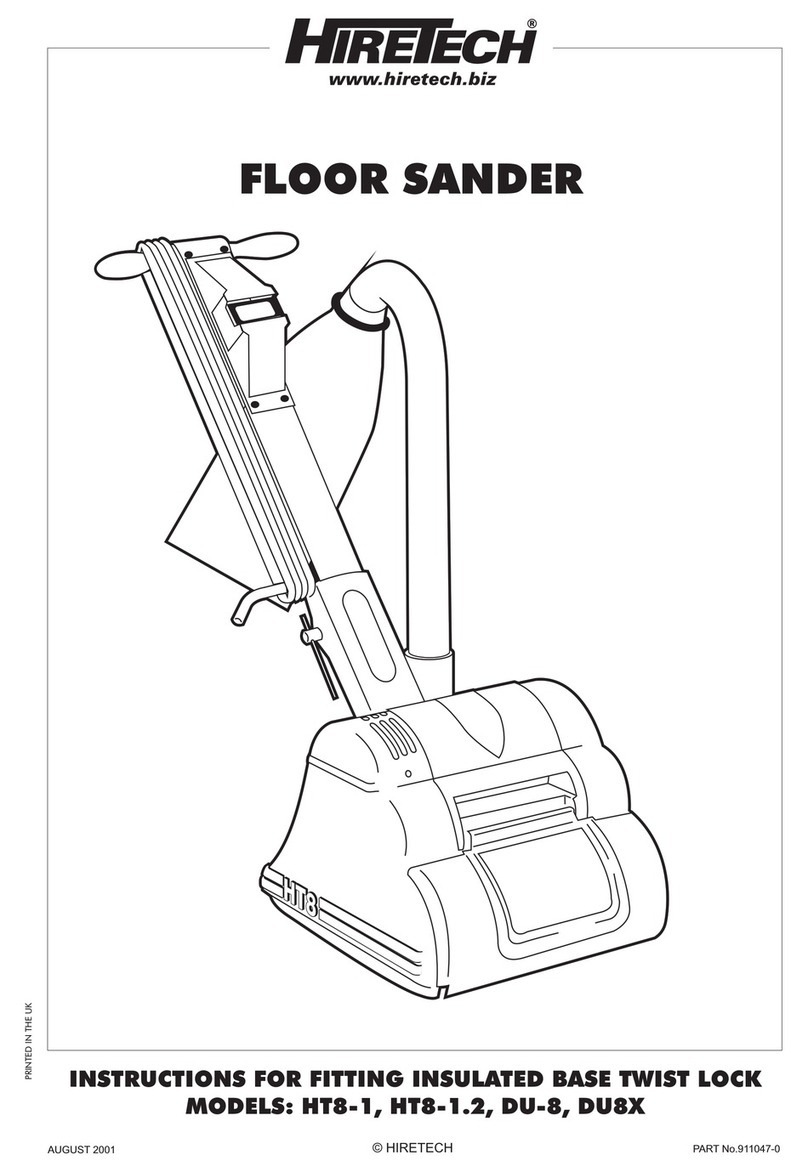
HireTech
HireTech HT8-1.2 User manual
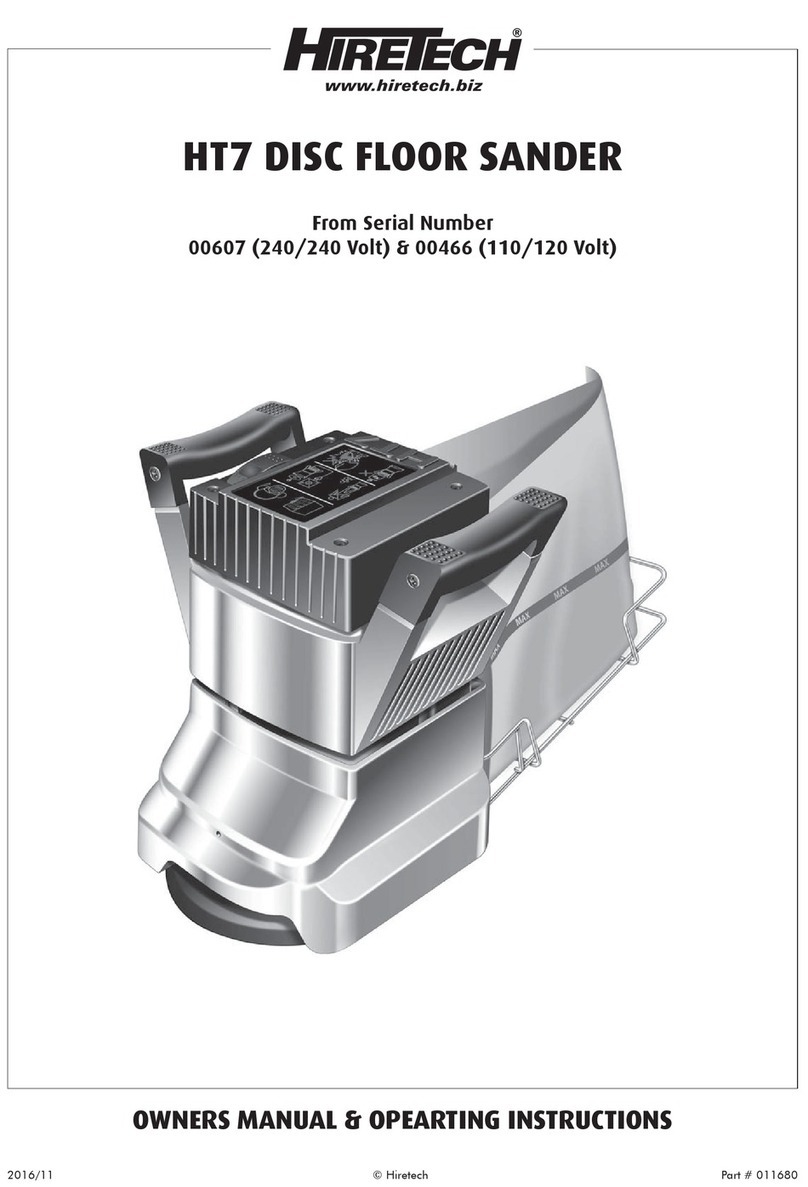
HireTech
HireTech HT7 System manual
